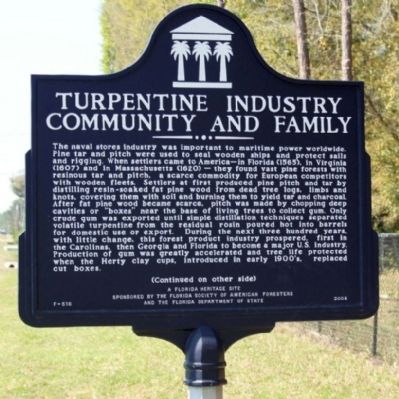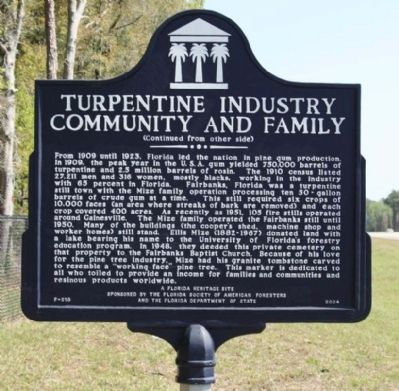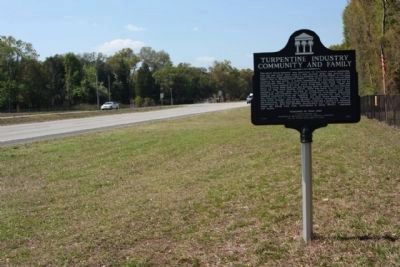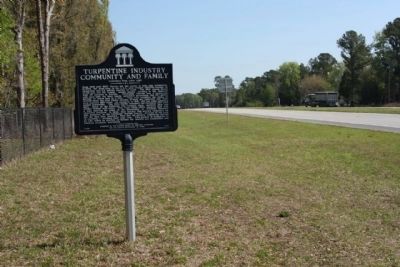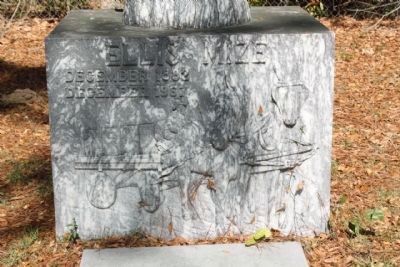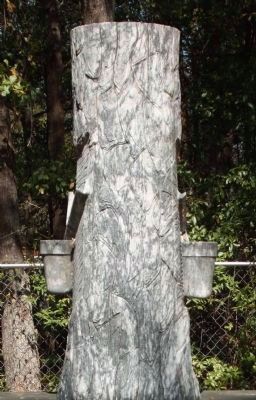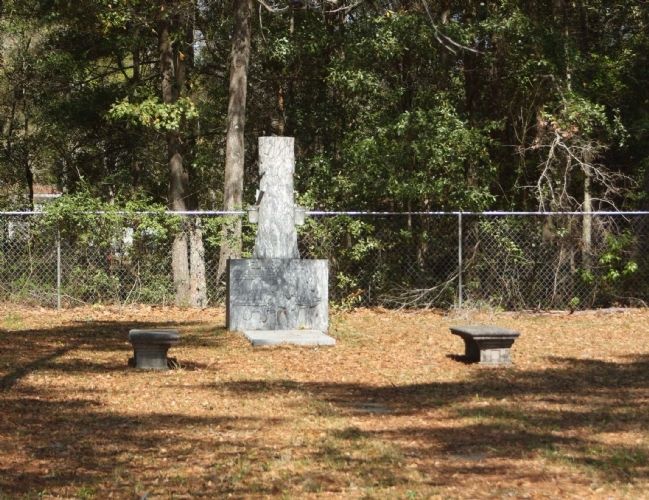Near Fairbanks in Alachua County, Florida — The American South (South Atlantic)
Turpentine Industry Community and Family
The naval stores industry was important to maritime power worldwide. Pine tar and pitch were used to seal wooden ships and protect sails and rigging. When settlers came to America - in Florida (1565), in Virginia (1607) and in Massachusetts (1620) - they found vast pine forests with resinous tar and pitch, a scarce commodity for European competitors with wooden fleets. Settlers at first produced pine pitch and tar by distilling resin-soaked fat pine wood from dead tree logs, limbs and knots, covering them with soil and burning them to yield tar and charcoal. After fat pine wood became scarce, pitch was made by chopping deep cavities or "boxes" near the base of living trees to collect gum. Only crude gum was exported until simple distillation techniques separated volatile turpentine from the residual rosin poured hot into barrels for domestic use or export. During the next three hundred years, with little change, this forest product industry prospered, first in the Carolinas, then Georgia and Florida to become a major U.S. industry. Production of gum was greatly accelerated and tree life protected when the Herty clay cups, introduced in early 1900's, replaced cut boxes.
Reverse
From 1909 until 1923, Florida led the nation in pine gum production. In 1909, the peak year in the U.S.A. gum yielded 750,000 barrels of turpentine and 2.5 million barrels of rosin. The 1910 census listed 27,2ll men and 3l6 women, mostly blacks, working in the industry with 65 percent in Florida. Fairbanks, Florida was a turpentine still town with the Mize family operation processing ten 50-gallon barrels of crude gum at a time. This still required six crops of 10,000 faces (an area where streaks of bark are removed) and each crop covered 400 acres. As recently as 1951, 105 fire stills operated around Gainesville. The Mize family operated the Fairbanks still until 1950. Many of the buildings (the cooper's shed, machine shop and worker homes) still stand. Ellis Mize (1882-1967) donated land with a lake bearing his name to the University of Florida's forestry education program. In 1948, they deeded this private cemetery on that property to the Fairbanks Baptist Church. Because of his love for the pine tree industry, Mize had his granite tombstone carved to resemble a "working face" pine tree. This marker is dedicated to all who toiled to provide an income for families and communities and resinous products worldwide.
Erected 2004 by Florida Society of American Foresters and the Florida Department of State. (Marker Number F-516.)
Topics. This historical marker is listed in these topic lists: Horticulture & Forestry • Industry & Commerce. A significant historical year for this entry is 1909.
Location.
29° 43.582′ N, 82° 15.293′ W. Marker is near Fairbanks, Florida, in Alachua County. Marker is on NE Waldo Road (State Road 24) near NE 65th Terrace, on the right when traveling west. Touch for map. Marker is in this post office area: Gainesville FL 32609, United States of America. Touch for directions.
Other nearby markers. At least 8 other markers are within 7 miles of this marker, measured as the crow flies. Major General John R Alison (approx. 3.3 miles away); Gainesville Regional Airport (approx. 3.3 miles away); Lynching in America / Lynching in Gainesville (approx. 5˝ miles away); Mt. Pleasant Cemetery (approx. 6 miles away); Thomas House (approx. 6.3 miles away); Chestnut Funeral Home (approx. 6.3 miles away); The Bailey House (approx. 6.3 miles away); Roper Park / Old City Park (approx. 6.4 miles away).
Credits. This page was last revised on February 14, 2021. It was originally submitted on April 27, 2011, by Mike Stroud of Bluffton, South Carolina. This page has been viewed 1,372 times since then and 33 times this year. Last updated on February 13, 2021, by Jason R. Surratt of Aurora, Colorado. Photos: 1, 2, 3, 4, 5, 6, 7, 8. submitted on April 27, 2011, by Mike Stroud of Bluffton, South Carolina. • J. Makali Bruton was the editor who published this page.
